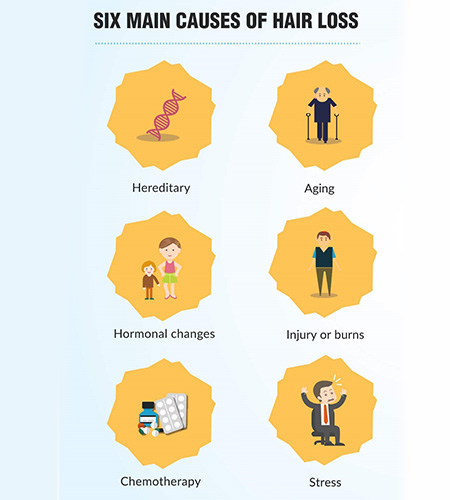Causes of Hair Loss

Blogs
Learn about our history and workHair loss is the most common problem which affects millions of men, women, and children. Half of adults both men and women will experience hair loss of hair by the time they are 60,
To lose hairs between 50-100 is normal which part of the hair renewal process is. Most people suffer from excessive hair loss at one time in their life.
There are many reasons for hair loss including medication, radiation, chemotherapy, chemical exposure, hormonal and nutritional deficiency, thyroid problem, generalized or local skin disease, and excess stress.


Classification of Hair Loss In Men
The Norwood system of classification is the most commonly used classification for hair loss in men. It defines two major patterns and several less common types.
In the regular Norwood pattern, two areas of hair loss gradually enlarge to produce a recession at the temples and thinning in the crown. These regions coalesce until the entire front; top and crown (vertex) of the scalp are bald.
Classification of Hair Loss In Women
The Ludwig Classification uses three stages to describe female pattern genetic hair loss:
• Type I (mild)
• Type II (moderate)
• Type III (extensive)
In all three Ludwig stages, there is hair loss on the front and top of the scalp with relative preservation of the frontal hairline. The back and sides may or may not be involved. Regardless of the extent of hair loss, only women with stable hair on the back and sides of the scalp are candidates for hair transplant surgery.
Type I: Early thinning that can be easily camouflaged with proper grooming. Type I patients have too little hair loss to consider surgical hair restoration.
Type II: Significant widening of the midline part and noticeably decreased volume. Hair transplantation may be indicated if the donor area in the back and sides of the scalp is stable.
Type III: A thin, see-through look on the top of the scalp. This is often associated with generalized thinning.


Embryology of Hair
Hair formation, hair follicle development is an excellent example of two distinct developmental processes: epithelial-mesenchymal interactions and pattern formation.
The differentiated hair follicle contains 20 or more different cell types. Melanocytes, which are responsible for hair color is neural crest origin, and with aging, their numbers decrease leading to the whitening of the hair.
Hair follicle development begins as an epithelial-mesenchymal interaction between weeks 9 – 12. Lanugo hair is replaced in the late fetal or early neonate by value and terminal hairs. Under the influence of steroidal hormones, the second round of development occurs during puberty.
Genes In Hair Loss
Many people have believes that “hair loss comes from the mother’s side of the family. There is a slightly higher frequency of inheritance from the mother’s side but male pattern hair loss is a genetic trait that can be inherited from either parent.
Research suggests that it is a polygenic trait, involving more than one gene, and it is much more complicated than originally thought.


Psychological Impact of Hair Loss
Hair loss is not only a physical issue; it can also have a significant psychological and mental impact. This impact may be more obvious for women but the effects on men should not be underestimated. Hair loss can result in withdrawal, anxiety, and depression.
Research has been undertaken to more clearly understand the psychological impact of hair loss. This research can overcome sufferers recognize the emotions they may experience and treatment protocol. The research has also demonstrated that there are several common reactions to hair loss. These include:
• Panic
• Denial
• Shyness
• Low self-esteem
• Work-related problems
• Jealousy
• Isolation
• Negative effects on social life
Role of Hormones In Hair Loss
Hormones are biochemical products produced by various glands located throughout the body. These glands release hormones directly into the bloodstream, spreading the chemicals throughout the body.
Testosterone, the major male sex hormone, and other hormones that have masculinizing effects are made primarily in the testicles. When testicles develop and enlarge during puberty, hormones reach a level in the bloodstream which is sufficient to commence the balding process.
The adrenal glands, located above each kidney in both men and women also produce androgenic hormones. In females, the ovaries are an additional source of hormones that can affect hair growth.
Role of Age In Hair Loss
It is true that genes and hormones are not sufficient on their own to cause baldness. When a person has reached puberty, susceptible hair follicles must continually be exposed to DHT hormone over time for hair loss to happen.
The age at which these effects manifest varies from person to person and is related to an individual’s genetic composition, the testosterone level in the bloodstream, and the follicular sensitivity to the hormone.


Anatomy of Hair
Hair is a complicated structure. It is comprised of the root (or follicle) and the shaft (the visible part of hair). The root is enclosed in the hair follicle and ends down to the bulb.
Dermal papilla cell is situated at the base of the hair follicle which is a biological structure that is very important to the follicle.
They bear capillary vessels that send nutritive elements from blood to cells.
In dermal papilla also lie the androgens receptors and fibroblasts, which have an important role in the hair growth cycle.
The shaft is the visible dead part of the hair and consists of 3 layers.
- Cuticle, the outermost layer of the hair. It is made of keratin.
- The cortex contains pigment (melanin) that defines hair color. The cortex defines hair texture which includes keratin and is responsible for the shaft growth
- The medulla is an innermost layer of the hair that is made of cells that form a shaft through the middle of the hair.



